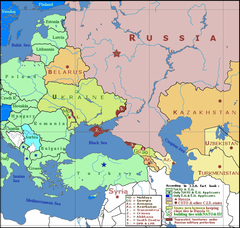Frozen conflict

In international relations, a frozen conflict is a situation in which active armed conflict has ended, but no peace treaty or other political framework resolves the conflict to the satisfaction of the combatants. Therefore, legally the conflict can start again at any moment. This creates an environment of insecurity and instability.
The de facto situatiom may or may not match the official position asserted by either party to the conflict. For example, in the Division of Korea, both North Korea and South Korea officially assert claims to the entire peninsula; however, there exists a well-defined border between the two countries' areas of control.
Frozen conflicts sometimes result in partially-recognized states. The Republic of South Ossetia is a product of the frozen Georgian–Ossetian conflict. It is recognized by eight other states,. Five of these states are UN member states. The other three are partially-recognized states themselves.
Since aggressors are not defeated, frozen conflicts can be seen as appeasement and rewarding aggression.[1]
Examples
[change | change source]Examples of frozen conflicts are:
- Transnistria controls the easternmost part of Moldova. The state started after two years war (1990-92). The conflict is unresolved, Moldova still claims the territory.
- The island of Cyprus is divided by the Republic of Cyprus, and Northern Cyprus. This is the result of a conflict in 1974. Only Turkey recognizes Northern Cyprus.
- Abkhazia and South Ossetia are the result of two wars in the 1990s: the South Ossetia war (1991–1992) and the War in Abkhazia (1992–1993). Neither state is recognized, and they are considered part of Georgia.
- Western Sahara is divided between Morocco, and the POLISARIO Front.
References
[change | change source]- ↑ Jung, Karsten (2023). "A New Concert for Europe: Security and Order After the War". The Washington Quarterly. 46: 25–43. doi:10.1080/0163660X.2023.2192137.
